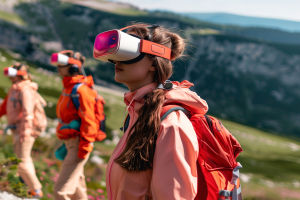
These days, it feels like everyone's talking about the “metaverse.” And with that, words like VR, AR, and MR keep popping up. But what exactly is virtual reality? How many types are there?
Where is it used? And how is it different from AR? Don't worry — we're going to walk through all of this together in plain, local English. By the end of this article, you'll feel like a VR pro.
What exactly is virtual reality?
VR stands for “Virtual Reality,” which simply means a computer-generated world that we can look at and even interact with. Instead of just watching something on a screen, we can actually feel like we're inside it. To do this, we usually wear a headset or VR goggles, and sometimes even gloves or other gear. These devices help us see and move inside that 3D world. The cool part? It feels like we're really there — even though everything is digital.
Together with AR (Augmented Reality) and MR (Mixed Reality), VR belongs to the larger tech group called “Extended Reality,” or XR for short.
How does VR work?
To make a virtual world feel real, computers use a mix of 3D design, sensors, and smart programs. The headset tracks how we move and look around, so the view changes just like in real life. Some systems even let us use hand gestures or special tools to touch or move things in the virtual world. Over time, the technology is getting better and more realistic — and we don't need huge machines or crazy gear anymore to enjoy it.
The 3 main types of VR
There are three kinds of VR experiences, depending on how deep we go into the virtual world:
1. Non-immersive VR
This is the lightest type. It usually means we're using a computer or phone to look at a 3D space, and maybe click or scroll through it. But we're still aware of the real world around us. For example, using a website to design your dream room or play a simple 3D game.
2. Semi-immersive VR
This one's a bit more intense. We might use a VR headset or screen to explore 3D content, but it doesn't track our body's full movement. A good example is a flight simulator. Pilots and trainees use these to learn how to fly without leaving the ground.
3. Fully immersive VR
Now this is the real deal. It gives us a full experience using sight, sound, and sometimes even touch. We wear special headsets, gloves, and sometimes use platforms like treadmills or bikes. This kind of VR makes us feel like we're walking through another world. It's already used in games and health training, and it keeps improving.
Where is VR used in real life?
Let's look at some real-world uses of VR that are already making a difference:
1. Training
Training someone for tough or risky jobs can be expensive or unsafe in real life. VR helps solve this. It's used to teach people how to handle emergencies, do complex tasks, or react to intense situations — all without real-world danger. Think firefighters, paramedics, police, or doctors in operating rooms.
2. Education
Students can “visit” ancient cities or explore space from their classrooms using VR. It adds a layer of excitement and connection that textbooks just can't match. Imagine learning about Ancient Greece while standing in a virtual temple!
3. Healthcare
VR is helping doctors, patients, and researchers in many ways. It can support treatment for anxiety or phobias and help people manage stress. For medical professionals, VR can explain conditions to patients or train on surgeries more safely.
4. Real estate and architecture
Looking to buy or design a home? VR makes it easier to visualize spaces. Buyers can take virtual tours of homes without stepping inside. Architects and engineers can show 3D models of future buildings — even walk clients through the designs in real time.
5. Entertainment
Of course, VR is also changing how we play. Games, movies, and even concerts can now feel much more personal and real. Want to explore a haunted house or visit a faraway land? VR can make it happen — from your couch.
So, VR or AR — what's the difference?
Here's the simple answer:
VR puts us in a completely made-up world. AR, on the other hand, adds digital stuff into our real world. For example, when we use an app that places digital furniture in our living room using our phone camera — that's AR. But when we wear a headset and step into a digital world, that's VR.
Final thoughts — and a question for you, Lykkers
We've come a long way from thinking of VR as just a “sci-fi” thing. Today, it's real, useful, and exciting. Whether for work, learning, or fun, VR is opening up new doors every day.
So, Lykkers, we're curious — have you ever tried VR? If not, what would you want to experience first in a virtual world? Let us know your thoughts and let's imagine the future together!


